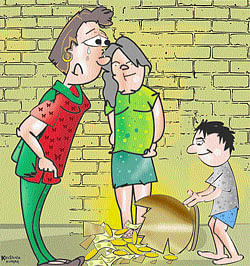
“Where else can we play?” Tanya longed to retort. Checking herself as she sensed her mother’s weariness, she led her younger brother outside. Their apartment opened onto the street, and the siblings sat at the front door thinking of how their lives had changed.
Six months ago, Tanya and Tarun had lived in a spacious house. They had dined out, entertained friends, enjoyed vacations, owned fancy gadgets and seen the latest films. When Mr Mehra had gone on an assignment to Malaysia, Mrs Mehra and the children had accompanied him.
The Mehras had visited Melaka, a short drive from Kuala Lumpur. Governed in turn by the Portuguese, Dutch and English, Melaka was renowned for its monuments in those architectural styles. Its previous past was just as interesting, explained Mr Mehra.
Over five centuries ago, Sultan Mansur Shah of Melaka, had married a Chinese princess who had brought with her the customs of her people. Through similar alliances over the years, Melaka had become famous for its blend of cultures and cuisines.
While Mr Mehra spent an instructive morning at the Melaka Museum, Tanya, Tarun and their mother had explored Melaka in a trishaw (half-tricycle, half-rickshaw) and shopped for souvenirs.
At one of their stops, a young woman had presented them a big jar engraved with a dragon. “This has been in my family for generations,” she said. “My great-grandfather told me I would know when to part with it. May it bring you luck!”
“Luck!” exclaimed Tanya bitterly, as she and Tarun recalled that episode. Soon after their return to India, Mr Mehra had passed away following a heart attack, leaving his wife and children in shock; also, close to penury. Unknown to Mrs Mehra and the children, they had been living beyond their means and were heavily in debt.
Tanya and Tarun watched in stunned disbelief as their home and prized possessions were sold. Discontinuing their expensive education, they attended a small school, where Mrs Mehra found a job as a teacher.
Accustomed to skilled domestic help, Mrs Mehra could barely cope with the household chores, while Tanya and Tarun — who had never worked at anything other than their studies — struggled to assist her. The end of each day found the three of them exhausted and irritable.
“Where is the Melakan jar anyway?” asked Tarun, to distract his sister who seemed about to cry. “It escaped the auctioneer because it was packed away.” Mrs Mehra entered, as the children unearthed the jar from a box under Tanya’s bed. Tears filled her eyes at the memories it aroused. “I never want to see this again,” she said, pulling it roughly out of Tanya’s grasp.
“You’ve broken it, Mummy,” said Tarun, as the lower portion of the jar came loose. As Mrs Mehra and her children gaped in amazement, hundreds of strange-looking coins rained on the floor. “How could we not have noticed them before?” said Mother. She peered into the jar and saw the reason. A round piece of wood was wedged tightly at the bottom, concealing — as long as the jar was intact — the treasure.
Treasure it was! The Mehras’ fortunes improved dramatically, for a wealthy collector paid handsomely for the Melakan coins of the 16th, 17th and 18th centuries. While Tanya and Tarun would always miss their fun-loving father, they and their mother were able to return to some semblance of their earlier lifestyle.
Tanya and Tarun retained one gold coin. Predating its colonial counterparts, it bore the face of Hang Li Po, Sultan Mansur Shah’s foreign consort. Somehow, the princess reminded them of the generous Chinese gift-giver who had mysteriously saved them.
Besides — like the jar which they managed to mend — they cherished it as a memento of marvellous Melaka!